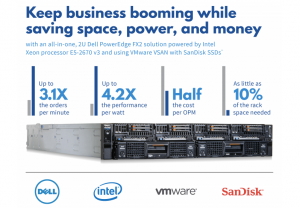 The great part of the VMware hyperconverged model is that it’s software-centric, which means customers get the benefit of great hardware partners who are always upping their game.
The great part of the VMware hyperconverged model is that it’s software-centric, which means customers get the benefit of great hardware partners who are always upping their game.
Today’s interesting VSAN performance results come from Dell. Recently, they engaged with Principled Technologies to benchmark a Dell FX2 stuffed with SanDisk flash against a similar HP server using an external storage array.
It wasn’t even close, folks.
Let’s step behind the scenes, if you’re interested?
I Guess I’m A Performance Geek
Every time I see any public performance study, I take a few moments to really understand what I’m looking at. Different teams come at things different ways, as long as everything is fully disclosed, I’m usually OK unless there’s some intentional sleight-of-hand at play.
As you dig through, you’ll notice that the comparison is a modern, all-flash hyperconverged setup against a 2012-vintage external hybrid storage array. Fair comparison, or perhaps unfair?
 Actually, when you think about it, it’s quite reasonable. A 2012-vintage array would be three years into its useful life — about the time many folks would be looking for the next thing.
Actually, when you think about it, it’s quite reasonable. A 2012-vintage array would be three years into its useful life — about the time many folks would be looking for the next thing.
And, thankfully, there are some great new options to consider.
Three years ago, all-flash was an expensive proposition — these days it’s far more reasonable. Three years ago, there weren’t hyperconverged solutions like vSphere and VSAN. Now they’ve been in the market for a while.
And there certainly weren’t cool server packages like the Dell FX2 🙂
If someone is looking for a new round of infrastructure, this document provides an accurate assessment of what they can expect from a modern Dell all-flash hyperconverged solution: way more performance, way less data center footprint, etc. etc.
Just goes to show how fast infrastructure technology evolves in a very short period of time, and what can result when hyperconverged is all about software.
I did appreciate the Dell test harness: 24 SQLserver images, 20GB each. Nice, healthy workload. Better yet, they used the default VSAN settings right out of the box — no tuning or optimization was evident.
Being the geek I am, the results would have been even *more* interesting if we could get the next level of detail: average response times for the transactions, variability of response times, how much IO load was being generated on the back end, etc.
But I quibble — as doing so would have made things very long indeed, and not everyone is up for that. Plenty of useful data here — a great piece of work.
The document makes its point well: Dell FX2 running VSAN on SanDisk is a cost-effective screamer — and probably a lot better than what you’re running today 🙂
A quick note: Dell has also recently published VDI numbers (Citrix/vSphere) on Nutanix, coming in at around ~75-80 VDI sessions per server. This is rather unique, as Nutanix doesn’t ever publish verifiable performance numbers.
While we won’t be testing Citrix VDI anytime soon, we’re already getting ~200 VDI sessions in our Horizon/VSAN testing.
And that’s a very big difference, folks 🙂
